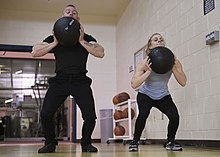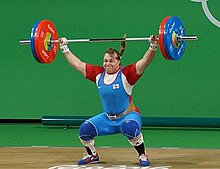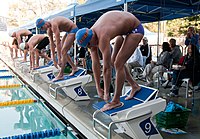
Calisthenics or callisthenics (/ˌkælɪsˈθɛnɪks/) is a form of strength training that utilizes an individual's body weight as resistance to perform multi-joint, compound movements with little or no equipment.

Physical fitness is a state of health and well-being and, more specifically, the ability to perform aspects of sports, occupations and daily activities. Physical fitness is generally achieved through proper nutrition, moderate-vigorous physical exercise, and sufficient rest along with a formal recovery plan.

The clean and jerk is a composite of two weightlifting movements, most often performed with a barbell: the clean and the jerk. During the clean, the lifter moves the barbell from the floor to a racked position across the deltoids, without resting fully on the clavicles. During the jerk, the lifter raises the barbell to a stationary position above the head, finishing with straight arms and legs, and the feet in the same plane as the torso and barbell.

A squat is a strength exercise in which the trainee lowers their hips from a standing position and then stands back up. During the descent, the hip and knee joints flex while the ankle joint dorsiflexes; conversely the hip and knee joints extend and the ankle joint plantarflexes when standing up. Squats also help the hip muscles.

The deadlift is a weight training exercise in which a loaded barbell or bar is lifted off the ground to the level of the hips, torso perpendicular to the floor, before being placed back on the ground. It is one of the three powerlifting exercises, along with the squat and bench press, as well as a frequent lift in strongman.

An isometric exercise is an exercise involving the static contraction of a muscle without any visible movement in the angle of the joint. The term "isometric" combines the Greek words isos (equal) and -metria (measuring), meaning that in these exercises the length of the muscle and the angle of the joint do not change, though contraction strength may be varied. This is in contrast to isotonic contractions, in which the contraction strength does not change, though the muscle length and joint angle do.

Plyometrics, also known as jump training or plyos, are exercises in which muscles exert maximum force in short intervals of time, with the goal of increasing power (speed-strength). This training focuses on learning to move from a muscle extension to a contraction in a rapid or "explosive" manner, such as in specialized repeated jumping. Plyometrics are primarily used by athletes, especially martial artists, sprinters and high jumpers, to improve performance, and are used in the fitness field to a much lesser degree.
The snatch is the first of two lifts contested in the sport of weightlifting followed by the clean and jerk. The objective of the snatch is to lift the barbell from the ground to overhead in one continuous motion. There are four main styles of snatch used: snatch, split snatch, power snatch, and muscle snatch. The full lift is the most common style used in competition, while power snatches and muscle snatches are mostly used for training purposes, and split snatches are rarely used. Any of these lifts can be performed from the floor, from the hang position, or from blocks. In competition, only lifts from the floor are allowed.

In weight training, a kettlebell is a cast-iron or cast-steel ball with a handle attached to the top. It is used to perform many types of exercises, including ballistic exercises that combine cardiovascular, strength and flexibility training. Kettlebells are the primary equipment used in the weight-lifting sport of kettlebell lifting.
Circuit training is a form of body conditioning that involves endurance training, resistance training, high-intensity aerobics, and exercises performed in a circuit, similar to high-intensity interval training. It targets strength building and muscular endurance. An exercise "circuit" is one completion of all set exercises in the program. When one circuit is completed, one begins the first exercise again for the next circuit. Traditionally, the time between exercises in circuit training is short and often with rapid movement to the next exercise.
Complex training, also known as contrast training or post-activation potentiation training, involves the integration of strength training and plyometrics in a training system designed to improve explosive power. According to Jace Derwin:
Strength training and plyometric training are both effective measures for increasing athletic performance independent of each other, but a true program designed for power-based athletes needs to incorporate both disciplines. A study done in 2000 in the NSCA's Journal of Strength and Conditioning Research measured three different training protocols: strength training, plyometric training, and a combination of both. The group that used combined methods was the only group that showed significant increases in BOTH strength and power.
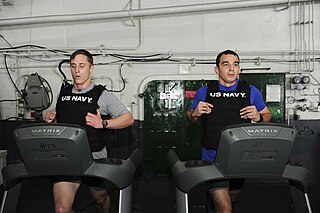
Weighted clothing are garments that have heavy materials incorporated into them, to add weight to various parts of the body, usually as part of resistance training. The effect is achieved through attaching weighted pieces to the body which leave the hands free to grasp objects. Unlike with held weights or machines, weighted clothing can leave users more able to do a variety of movements and manual labour. In some cases certain weighted clothing can be worn under normal clothing, to disguise its use to allow exercise in casual environments.

A vertical jump or vertical leap is the act of jumping upwards into the air. It can be an exercise for building both endurance and strength, and is also a standard test for measuring athletic performance. It may also be referred to as a Sargent jump, named for Dudley Allen Sargent.

The following outline is provided as an overview of and topical guide to exercise:
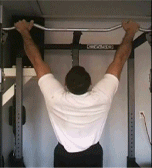
Bodyweight exercises are strength training exercises that use an individual's own weight to provide resistance against gravity. Bodyweight exercises can enhance a range of biomotor abilities including strength, power, endurance, speed, flexibility, coordination and balance. Such strength training has become more popular among recreational and professional athletes. Bodyweight training uses simple abilities like pushing, pulling, squatting, bending, twisting and balancing. Movements such as the push-up, the pull-up, and the sit-up are among the most common bodyweight exercises.

Ballistic training, also known as compensatory acceleration training, uses exercises which accelerate a force through the entire range of motion. It is a form of power training which can involve throwing weights, jumping with weights, or swinging weights in order to increase explosive power. The intention in ballistic exercises is to maximise the acceleration phase of an object's movement and minimise the deceleration phase. For instance, throwing a medicine ball maximises the acceleration of the ball. This can be contrasted with a standard weight training exercise where there would be a pronounced deceleration phase at the end of the repetition i.e. at the end of a bench press exercise the barbell is decelerated and brought to a halt. Similarly, an athlete jumping whilst holding a trap bar maximises the acceleration of the weight through the process of holding it whilst they jump- where as they would decelerate it at the end of a standard trap bar deadlift.

The Bulgarian bag, also known as the Bulgarian training bag, is a crescent-shaped exercise equipment used in strength training, plyometric weight training, cardiovascular training, and general physical fitness. The bags are made of leather or canvas and filled with sand; they weigh from 11 pounds (5.0 kg) to 50 pounds (23 kg) and have flexible handles to allow for both upper and lower body training, and for building grip strength.
Football strength is a training regime, considered the most complex physical quality to be developed by an athlete. The training regime, exercises used, how the exercises are performed, and the types of equipment all play important roles in achieving desired results.

Physical training has been present in human societies throughout history. Usually, it was performed for the purposes of preparing for physical competition or display, improving physical, emotional and mental health, and looking attractive. It took a variety of different forms but quick dynamic exercises were favoured over slow or more static ones. For example, running, jumping, wrestling, gymnastics and throwing heavy stones are mentioned frequently in historical sources and emphasised as being highly effective training methods. Notably, they are also forms of exercise which are readily achievable for most people to some extent or another.
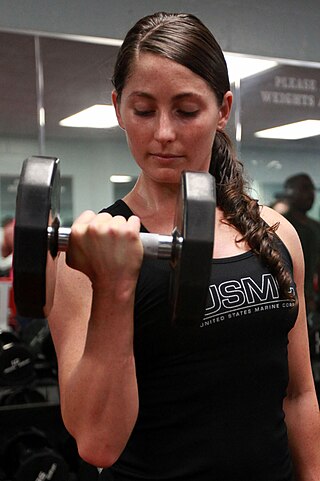
Unilateral training involves the performance of physical exercises using one limb instead of two. Such exercises should be considered as being distinct from bilateral, two limbed, exercises. For example, unilateral squats use one leg, and bilateral squats use two legs. A unilateral bench press uses one arm and a bilateral bench press two arms. Depending on the exercise, this may also entail using different equipment i.e. a dumbbell instead of a barbell. Unilateral exercise is commonly involved in comprehensive training regimes and especially those of professional sports people and athletes. Usually it is used in addition to bilateral training as opposed to instead of it. Unilateral training can yield numerous benefits including improving a person's muscle balance between the left and right sides of their body, improving their sense of balance, and helping to avoid or rehabilitate injury.

